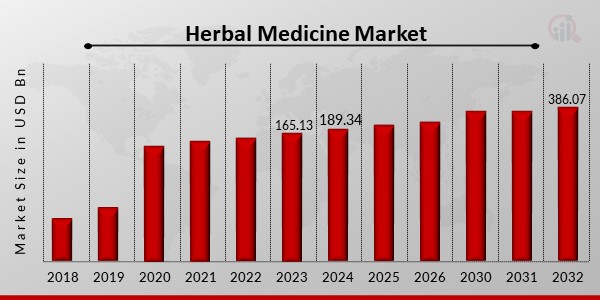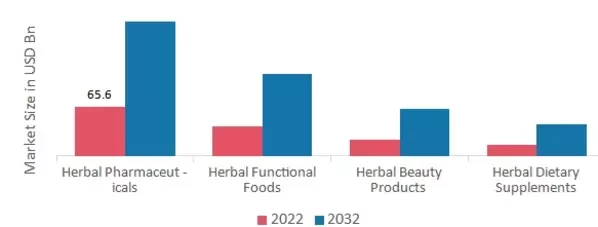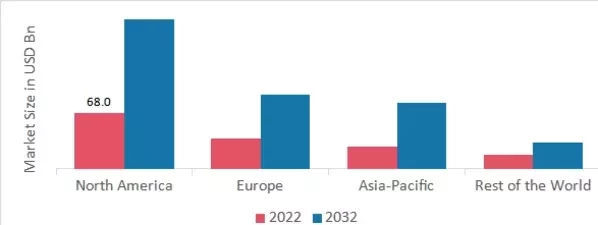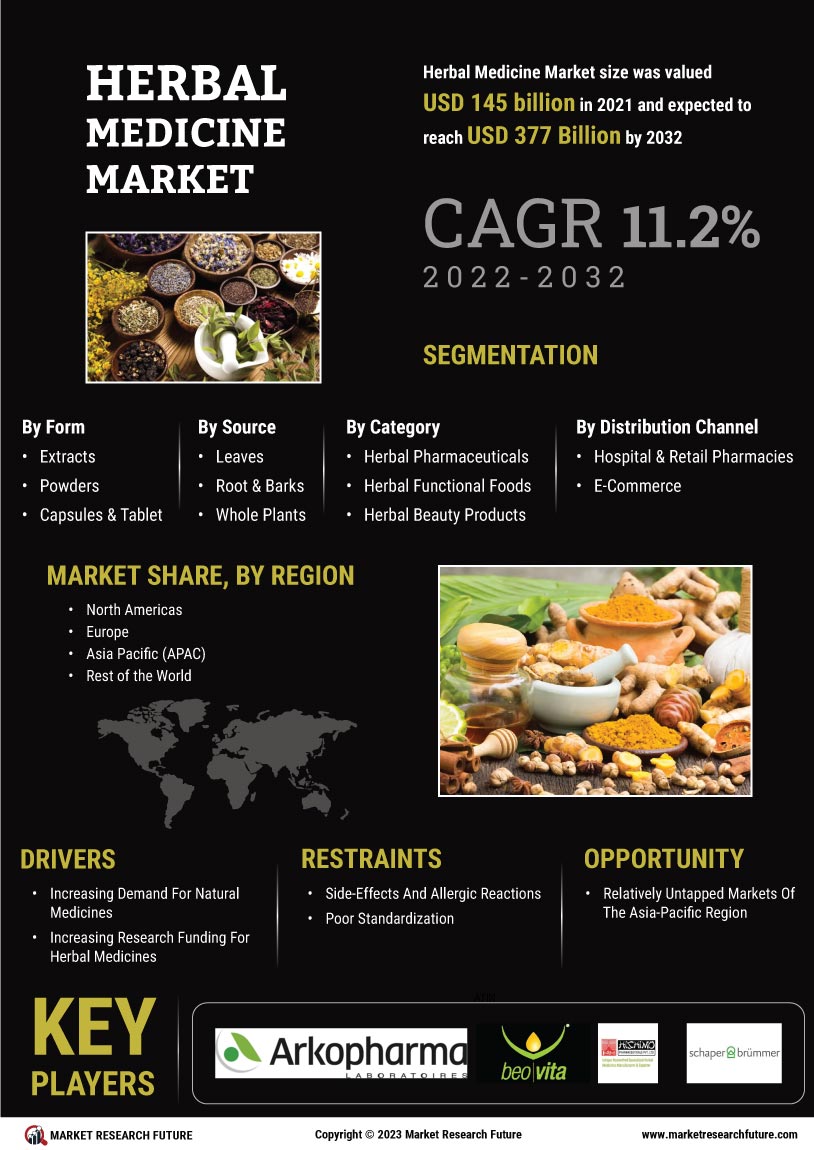Global Herbal Medicine Market Overview
The Herbal Medicine Market Size was valued at USD 165.13 Billion in 2023 and is projected to grow from USD 189.34 Billion in 2024 to USD 386.07 Billion by 2032, exhibiting a compound annual growth rate (CAGR) of 11.34% during the forecast period (2024 - 2032). The demand for herbal medicinal goods has grown as people become more aware of allopathic medications' side effects and the advantages of using them instead. The expanding population, coupled with an increase in the prevalence of chronic diseases, is another market driver impacting market growth.

Source: Secondary Research, Primary Research, MRFR Database and Analyst Review
Herbal Medicine Market Trends
- Consumer preferences for natural and herbal goods are driving the market growth
The market CAGR for herbal medicines will rise due to consumer preferences for natural and herbal goods. Natural goods like herbal medications and health supplements are popular among young people and those close to retirement. As a result, healthcare spending has changed as more senior citizens use herbal medications to maintain their active lifestyles. The market for herbal medicines has grown due to the COVID-19 epidemic, which has been spreading across the globe. Because of the lockdown limitations, most people could not go to fitness facilities like gyms and sports clubs to improve their fitness and immunity. As a result of the growing emphasis on developing immunity against COVID-19, the market for herbal medications grew. Vendors extensively promoted online sales during the lockdowns, particularly through brand-owned e-commerce platforms, and provided discounts on well-known herbal medications. During the forecast period, these factors are anticipated to fuel the market for herbal medicines.
The general population's growing trend of self-medication is anticipated to be favorable for the market for herbal medicines. A sizable and expanding segment of the public opposes the use of chemically produced medicines because of the various adverse effects they produce. Due to growing public awareness of the advantages of herbal medicines, which have been used for many years without any negative side effects, more people are choosing to use them to treat common health problems like fever, headache, cough, cold, lower-degree burns, digestive problems, and other similar issues.
As an alternative to conventional medications, herbal treatments are used in herbal therapies. People use them to relieve symptoms, treat or prevent ailments, boost energy, unwind, or reduce weight. Herbs are not subject to the same strict testing and regulations as medicines. Herbal medications are mostly used to treat chronic illnesses and promote health. However, their use has increased as a result of the failure of modern medicine to treat serious conditions like advanced cancer or newly emerging infectious diseases. The market for herbal medicine will rise due to the increase in demand, and new providers will have the possibilities to meet comparable demands. Thus, driving the herbal medicine market revenue.
Herbal Medicine Market Segment Insights
Herbal Medicine Form Insights
The market segments of herbal medicine, based on form includes Extracts, Powders, Capsules & Tablets and Syrups. The capsules & tablets segment dominated the market. Several of these medications are offered as pills and capsules in the market. Additionally, taking herbal capsules and pills is mentioned in increasing prescriptions. This market segment is anticipated to maintain its dominance in the market during the forecast period due to the growing use of herbal products in the pharmaceutical industry.
Herbal Medicine Distribution Channel Insights
The herbal medicine market segmentation, based on distribution channel, includes Hospital & Retail Pharmacies and E-Commerce. The e-commerce category generated the most income. The factors include accessibility in small towns and villages, the widespread use of mobile devices with internet connectivity, and the growing awareness of traditional medicine.
Herbal Medicine Category Insights
The market segmentation of herbal medicine, based on category includes Herbal Pharmaceuticals, Herbal Functional Foods, Herbal Beauty Products and Herbal Dietary Supplements. The herbal pharmaceuticals segment dominated the market. During the projection period, the segment size is anticipated to increase due to an expanding aging population and increased consumer awareness. The scale of the herbal medicine sector will also increase due to several other variables, including supplier advancements, very few or no negative effects, and the FDA's adoption of Current Good Manufacturing Practices (CGMP) for dietary supplements.
Figure 1: Herbal Medicine Market, by Category, 2023 & 2032 (USD Billion)

Source: Secondary Research, Primary Research, MRFR Database and Analyst Review
Herbal Medicine Type of Medicinal Plants Insights
The herbal medicine market segmentation, based on type od medicinal plants includes Marrubium Vulgare, Vaccinium Macrocarpon, Echinacea, Curcuma Longa, Camellia Sinensis, Actaea Racemose, Aloe Vera, Zingiber Officinale, Cocos Nucifera, Cinnamomum Spp and Allium Sativum. The echinacea segment dominated the market. The most popular herbal medicine among consumers is echinacea, the third most popular herbal supplement in the United States' major retail distribution network. The demand for these products was boosted by an increase in the number of clinical studies proving the health benefits of echinacea, which in turn helped the segment earn the greatest revenue share. Echinacea can cut the duration of the common cold by 26% and the likelihood of recurring colds by 60%.
Herbal Medicine Source Insights
The market segmentation of herbal medicine, based on source includes Leaves, Root & Barks, Whole Plants and Fruits. The whole plants segment dominated the market. These elements can be attributed to the product's capacity to treat a number of illnesses. The plant's roots, bark, fruits, flowers, leaves, stalks, and cloves are used to make traditional medicines.
Herbal Medicine Regional Insights
By region, the study provides the market insights into North America, Europe, Asia-Pacific and Rest of the World. The North American herbal medicine market area will dominate this market. Increasingly more customers, mostly in the U.S., are concerned about their health, and a strong green wave has caused a change in the public's perception of natural healthcare products. The alleged detrimental impacts of alternative medicines on people's health are to blame for this. In the U.S. market, this has aided the product's success.
Further, the major countries studied in the market report are The US, Canada, German, France, the UK, Italy, Spain, China, Japan, India, Australia, South Korea, and Brazil.
Figure 2: HERBAL MEDICINE MARKET SHARE BY REGION 2023 (USD Billion)

Source: Secondary Research, Primary Research, MRFR Database and Analyst Review
Europe herbal medicine market accounts for the second-largest market share. The market for natural components used in personal care and beauty products is expanding simultaneously, and this pattern is anticipated to continue. Europe is anticipated to significantly contribute to the market's growth in the future in response to this demand from European nations. In the market for health products in Europe, turmeric is rising in popularity. Further, the German market of herbal medicine held the largest market share, and the UK market of herbal medicine was the fastest growing market in the European region
The Asia-Pacific Herbal medicine Market is expected to grow at the fastest CAGR from 2024 to 2032. With more people utilizing the internet, customers are becoming more aware of the long-term advantages of herbal goods and are eager to use natural and herbal medicinal products. Additionally, the rise of these sectors has been supported by rising disposable income in developing nations like China, India, and Southeast Asian nations. Moreover, China’s market of herbal medicine held the largest market share, and the Indian market of herbal medicine was the fastest growing market in the Asia-Pacific region.
Herbal Medicine Key Market Players & Competitive Insights
Leading market players are investing heavily in research and development in order to expand their product lines, which will help the herbal medicine market, grow even more. Market participants are also undertaking a variety of strategic activities to expand their footprint, with important market developments including new product launches, contractual agreements, mergers and acquisitions, higher investments, and collaboration with other organizations. To expand and survive in a more competitive and rising market climate, herbal medicine industry must offer cost-effective items.
Manufacturing locally to minimize operational costs is one of the key business tactics used by manufacturers in the herbal medicine industry to benefit clients and increase the market sector. In recent years, the herbal medicine industry has offered some of the most significant advantages to market. Major players in the herbal medicine market attempting to increase market demand by investing in research and development operations include Arkopharma, Bayer AG, BEOVITA, Hishimo Pharmaceuticals, Schaper & Brümmer, ZeinPharma Germany GmbH, Venus Pharma GmbH, Dasherb Corp., Arizona Natural Products, Blackmores, Himalaya Holdings Ltd, and Dr. Willmar Schwabe India Pvt. Ltd.
Dasherb was established in 1992, became a Sino-German joint venture in 2002, and constructed its factory in 2009. Dasherb is dedicated to fusing traditional Chinese herbal medicine culture with cutting-edge medical technology to provide people all over the world with natural raw materials that are safe and effective. After 20 years of diligent labor, Dasherb Corp. has established more than 30 GAP/organic herb farms nationwide and has successfully received certification from the German PIC/S GMP, China GMP, USA FDA, Korea KGMP, HACCP, and ISO. The goods are widely used in medicine, cosmetics, food, health care items, drinks, and many more. They are distributed in more than 40 countries worldwide and have agents in 6 countries.
The French pharmaceutical firm Arkopharma was established in 1980 in Carros, close to Nice, focusing on nutritional supplements, natural medicine, and phytotherapy. With a presence in more than 60 nations, Arkopharma is currently the market leader in Europe for nutritional supplements and medications made from plants. In addition to offering natural medications for treatment and prevention, Arkopharma also wants to give doctors new possibilities for recommendations and prescriptions.
Key Companies in the market of herbal medicine include
- Arkopharma
- Bayer AG
- BEOVITA
- Hishimo Pharmaceuticals
- Schaper & Brümmer
- ZeinPharma Germany GmbH
- Venus Pharma GmbH
- Dasherb Corp.
- Arizona Natural Products
- Blackmores
- Himalaya Holdings Ltd
- Dr. Willmar Schwabe India Pvt. Ltd
Herbal Medicine Industry Developments
March 2021:The Lotus Botanicals brand was introduced by Lotus, one of India's well-known cosmetics brands. Customers can only order the assortment of skin and hair care items from Lotus Botanicals through Lotus Botanicals and other independent eCommerce channels using this e-commerce brand.
November 2020:The antiviral immunity-booster pills 'Viromune' were introduced by Indian herbal product manufacturer Kunnath Pharmaceuticals in India. The corporation hopes to generate a revenue of USD 266 million over the following three years through this launch.
June 2020:Dr. Willmar Schwabe India will purchase Sanat Products Limited. Through this purchase, the company will add to its existing distribution network in India by expanding its OTC distribution network. The organization aspires to develop a significant pan-Indian presence within five years.
Herbal Medicine Market Segmentation
Herbal Medicine Form Outlook (USD Billion, 2018-2032)
-
Extracts
-
Powders
-
Capsules & Tablets
-
Syrups
Herbal Medicine Distribution Channel Outlook (USD Billion, 2018-2032)
Herbal Medicine Category Outlook (USD Billion, 2018-2032)
Herbal Medicine Type of Medicinal Plants (USD Billion, 2018-2032)
-
Marrubium Vulgare
-
Vaccinium Macrocarpon
-
Echinacea
-
Curcuma Longa
-
Camellia Sinensis
-
Actaea Racemose
-
Aloe Vera
-
Zingiber Officinale
-
Cocos Nucifera
-
Cinnamomum Spp
-
Allium Sativum
Herbal Medicine Source Outlook (USD Billion, 2018-2032)
-
Leaves
-
Root & Barks
-
Whole Plants
-
Fruits
Herbal Medicine Regional Outlook (USD Billion, 2018-2032)
-
Germany
-
France
-
UK
-
Italy
-
Spain
-
Rest of Europe
-
Asia-Pacific
-
China
-
Japan
-
India
-
Australia
-
South Korea
-
Australia
-
Rest of Asia-Pacific
-
Rest of the World
-
Middle East
-
Africa
-
Latin America
| Report Attribute/Metric |
Details |
| Market Size 2022 |
USD 148.5 Billion |
| Market Size 2023 |
USD 165.13 Billion |
| Market Size 2032 |
USD 386.07 Billion |
| Compound Annual Growth Rate (CAGR) |
11.34% (2024-2032) |
| Base Year |
2023 |
| Market Forecast Period |
2024-2032 |
| Historical Data |
2018- 2022 |
| Market Forecast Units |
Value (USD Billion) |
| Report Coverage |
Revenue Forecast, Market Competitive Landscape, Growth Factors, and Trends |
| Segments Covered |
Form, Distribution Channel, Category, Type of Medicinal, Source, and Region |
| Geographies Covered |
North America, Europe, Asia Pacific, and the Rest of the World |
| Countries Covered |
The US, Canada, German, France, UK, Italy, Spain, China, Japan, India, Australia, South Korea, and Brazil |
| Key Companies Profiled |
Arkopharma, Bayer AG, BEOVITA, Hishimo Pharmaceuticals, Schaper & Brümmer, ZeinPharma Germany GmbH, Venus Pharma GmbH, Dasherb Corp., Arizona Natural Products, Blackmores, Himalaya Holdings Ltd, and Dr. Willmar Schwabe India Pvt. Ltd |
| Key Market Opportunities |
Multiple Applications Of Herbal Medicines |
| Key Market Dynamics |
Increasing Demand For Natural MedicinesIncreasing Research Funding For Herbal Medicines |
Herbal Medicine Market Highlights:
Frequently Asked Questions (FAQ) :
The herbal medicine market size was valued at USD 148.5 Billion in 2022.
The market is projected to grow at a CAGR of 11.34% during the forecast period, 2024-2032.
North America had the largest share in the market.
The key players in the market are Arkopharma, Bayer AG, BEOVITA, Hishimo Pharmaceuticals, Schaper & Brümmer, ZeinPharma Germany GmbH, Venus Pharma GmbH, Dasherb Corp., Arizona Natural Products, Blackmores, Himalaya Holdings Ltd, and Dr. Willmar Schwabe India Pvt. Ltd.
The echinacea category dominated the market in 2022.
The e-commerce category had the largest share in the market.






























